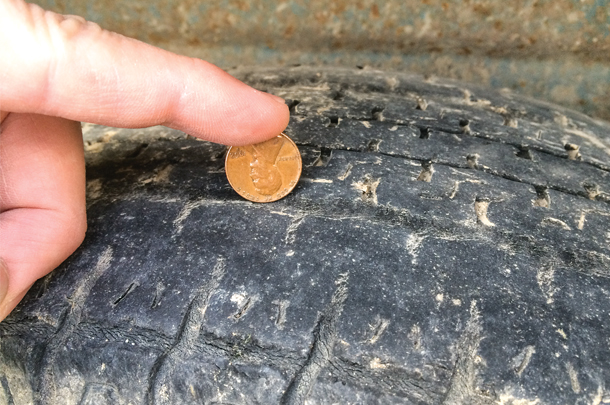Stock trailers are an essential tool in every beef cattle operation. They provide the ability to transport cattle and horses to various locations on the ranch, to distant pastures or to market.
In spite of their high importance and frequent use, the care and maintenance of stock trailers is often overlooked. Many of the issues that arise can potentially affect the health and safety of the livestock, the driver and passengers in your vehicle, and others on the road around you. This article will focus on items that should be reviewed or inspected on a frequent basis.
The towing vehicle
You should become familiar with the recommended weight limits for your vehicle. You can find these on the driver’s side door frame or in the vehicle owner’s manual. Gross axle weight rating, gross vehicle weight and gross combined vehicle weight rating are important terms and weight recommendations you should know and follow.
Your trailer should also have a small metal plate toward the front on the driver’s side that is inscribed with information about the empty trailer weight and gross loaded weight recommendation.
Additionally, be sure your vehicle’s tires are in good condition and properly inflated. Brakes need to be in good working order, including the trailer brake unit if your vehicle is so equipped.
Check the oil, coolant and other fluids are at their proper levels. Be sure your windows and mirrors are clean and properly adjusted. Wiper blades should be in good working condition. Check the fuel gauge and ensure you have sufficient fuel before starting out.
Insurance is another important item to check. Does your insurance policy cover the trailer? What about the cargo (animals) you are hauling? Are there limits on the amount covered?
The trailer
The hitch should be inspected to ensure it is properly latched. Safety chains should be inspected and properly attached. Check to ensure that the hooks used on the safety chains are of sufficient quality to hold the trailer in the event it should become detached from the ball.
It is not uncommon to find flimsy, weak hooks or even carabiners used to attach the safety chains.
Trailer lights should be checked every time you hook up. Malfunctioning or non-functioning trailer lights are a very common occurrence. Tail and marker lights, brake lights and turn signals will help drivers around you know what you are planning to do.
It is amazing how frequently it seems that you can park a trailer with all lights functioning properly – only to hook up the next time and have a problem.
Tires and wheels should be inspected frequently. Is there sufficient tread and are the tires properly inflated? Check for loose or missing lug nuts. Check for cracks in the rim and in the sidewall of the tire.

Be sure to check the spare tire. Is it properly inflated? Is it in a location where you can get to it with a loaded trailer? When buying new tires, be sure to check the production date stamped in the sidewall of the tire. Tires more recently manufactured will outlast tires that have been sitting in a warehouse for a few years.
Inspect the trailer floor. It should have a non-slip surface that provides sufficient footing for the animals to stand easily without falling. Loose, weak, broken or missing boards should be repaired or replaced.
Floors should be cleaned frequently and have excessive manure removed. Manure build-up can interfere with doors and panels, reduce footing and decrease the life of the trailer.
Check to see if doors and panels swing freely and latch properly. Doors should be secured either fully open or closed and latched. Make repairs as necessary. Repair or replace trailer sides or panels if they become damaged. Bent, broken or missing panels can cause bruising or even more severe injuries to livestock during transport.
Transporting livestock
Care should be taken not to overcrowd the trailer. BQA trailer-loading recommendations should be followed to allow for sufficient space and animal comfort during transportation.
Extended trips during hot or extremely cold weather should be planned with the well-being of the livestock in mind. This might mean late evening or early morning during the hottest times of the year.
Low-stress handling techniques should be used when loading livestock. This will help reduce injury to the animals as well as the handlers. Be sure to inspect the loading corrals and alleyways for broken boards, protruding nails and other potential problems.
Make sure you are prepared to handle minor breakdowns or emergencies. Is your jack sufficient to lift the axle on a loaded trailer? Do you have a lug wrench that fits the lug nuts on the trailer? Safety triangles or flares are also important to carry in the event of a breakdown.
As we pay attention to these important details when using stock trailers to transport livestock, we can each do our part in producing and delivering beef that is safe for the animals and provide a safe and wholesome product for our consumers. Visit www.bqa.org for additional information. ![]()
PHOTO 1: A bumper hitch properly latched with adequate safety chains attached properly and lights plugged in.
PHOTO 2: Tires should be inspected frequently for inflation, tread and any cracks or wear. Photos by Scott Jensen.

-
Scott Jensen
- University of Idaho - Owyhee County Extension
- Educator – Livestock and Range
- Email Scott Jensen





.jpg?height=auto&t=1735664860&width=285)



